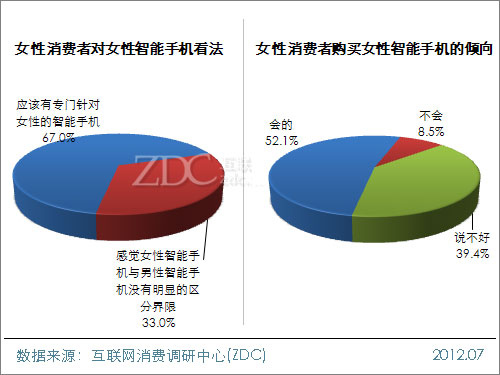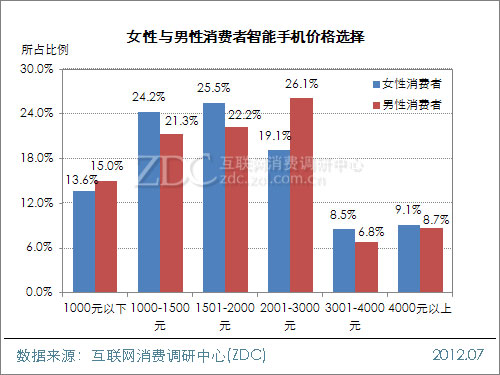In the era of traditional feature phones, there was a class of mobile phones that were targeted at women's mobile phones, specifically models targeted at female users. However, in 2007, the “smartphone†trend brought by Apple’s iPhone had disrupted everything before it. More than 90% of consumers who are preparing to replace mobile phones or newly purchase mobile phones have only “smart†eyes. Everything other than "smart" is out of date.
After five years of development, the status of “smart†in the hearts of mobile phone users has been ingrained, and the smart phone market has also turned from a blue ocean to a red sea. Android has become the smart phone operating system with the highest market share in the world, and Apple and Samsung have become the brands with the highest profit and handset shipments respectively. The right to speak in the smart phone market is in the hands of a few brands, and many brands are just followers of the market. From the point of view of products, the homogenization of smart phone products is constantly highlighted. It can be said that the manufacturers who competed in the smart phone field by traditional means had a hard time.
"Made by phone over the Internet" is a trick that Xiaomi uses when participating in the competition of smart phones. At present, this trick has worked and Xiaomi has succeeded. Then Xiaomi became the brand representative of the “unusual road†in the smartphone market, and some brands began to follow suit.
In addition to being unique in the way of involving in the field of smart phones, some brands have started to make a fuss about how to provide users with different smartphone products. The continuous emergence of female smartphones is a good example of this trend.
It is undeniable that the current smart phone market, regardless of hardware level, operating system, user behavior or ecosystem, is changing all the time, and every change needs behind the innumerable micro-innovation power. If there is no innovation in a product, it will be a terrible thing. Does that female smartphone have its own innovations? Do many women consumers buy it?

(Chart) Female consumers' perceptions of women's smartphones and purchasing trends ZDC survey data shows that women users are looking forward to female smartphones. Ninety-seven percent of female users believe that there should be smart phones specifically targeted at women, and more than half make it clear that they will buy them. In addition, 65.5% of female users are optimistic about the market prospects of female smart phones, and believe that this market has great potential and is worth exploring. It can be seen that those companies that intend to enter the field of smartphones or have exhausted themselves in the field of traditional smartphones can try to make a transition and follow the road of subdividing down the road. If they can't be sure, they can create a new world. What features of smart phones that women consumers who are currently on the market choose to choose more? Can you fully meet the needs of users?
ZDC chose to start researching this segment of the market by starting with a relatively concentrated model of female users. First of all, what are the similarities and differences between female users and male users in the purchase behavior of smart phones?
First, there is no significant difference between female users and male users when choosing a smart phone brand.
Consistent with the current high concentration of brand awareness in the smart phone market, current female users are choosing to focus on several mainstream brands when purchasing smart phones. There is no significant difference from the choice of male users. ZDC survey data is as follows:
Table female user and male user smart phone brand choice contrast
Ranking female users male users brand choice proportions brand select a ratio 1 Samsung 19.70% Samsung 18.80% 2 Nokia 17.30% Nokia 16.90% 3 Sony 12.40% HTC 13.00% 4 HTC 9.40%, Sony 7.20% 5 Apple 6.10% Apple 6.30% 6 Motorola 4.80% Huawei 6.30% 7 Lenovo Motorola 4.80% 4.50% 2.40% 8 Huawei, ZTE ZTE 2.10% 4.30% 9 3.90% 10 Lenovo millet millet 3.90% 11 1.80% other 19.50% other 14.60%
The smart phone brands currently used by female users and male users are mainly concentrated on Samsung, Nokia, HTC, Sony and Apple. They are international brands. Among the domestic mobile phone brands, Lenovo and Huawei have become the brands with the highest percentage of female and male users.
Second, female users are more likely to purchase smart machines below $2,000.
ZDC survey data shows that the price of smart phones purchased by female users is concentrated between 1000-2000 yuan, accounting for 49.7%, close to 50%. The percentage of male users who choose this price segment is 6.2% lower than female users. The proportion of male users who purchased the price segment model of 2001-3000 yuan reached 26.1%, which was 7 percentage points higher than female users. It can be seen that the price is also a major factor affecting the purchase of female users.

(Chart) Female and male users smart phone price selection Third, there are significant differences between the female and male users in the purchase of smart phones.
According to ZDC survey data, the primary consideration for female users when purchasing a smart phone is the appearance. The percentage of users who choose this item is close to 30%, followed by brand and price. The primary consideration for male users when purchasing a smart phone is brand, followed by appearance and user experience. This shows that design appeal to female users is very strong, and manufacturers who are dedicated to the research and development of female smartphones can do their homework in design.
After five years of development, the status of “smart†in the hearts of mobile phone users has been ingrained, and the smart phone market has also turned from a blue ocean to a red sea. Android has become the smart phone operating system with the highest market share in the world, and Apple and Samsung have become the brands with the highest profit and handset shipments respectively. The right to speak in the smart phone market is in the hands of a few brands, and many brands are just followers of the market. From the point of view of products, the homogenization of smart phone products is constantly highlighted. It can be said that the manufacturers who competed in the smart phone field by traditional means had a hard time.
"Made by phone over the Internet" is a trick that Xiaomi uses when participating in the competition of smart phones. At present, this trick has worked and Xiaomi has succeeded. Then Xiaomi became the brand representative of the “unusual road†in the smartphone market, and some brands began to follow suit.
In addition to being unique in the way of involving in the field of smart phones, some brands have started to make a fuss about how to provide users with different smartphone products. The continuous emergence of female smartphones is a good example of this trend.
It is undeniable that the current smart phone market, regardless of hardware level, operating system, user behavior or ecosystem, is changing all the time, and every change needs behind the innumerable micro-innovation power. If there is no innovation in a product, it will be a terrible thing. Does that female smartphone have its own innovations? Do many women consumers buy it?

(Chart) Female consumers' perceptions of women's smartphones and purchasing trends ZDC survey data shows that women users are looking forward to female smartphones. Ninety-seven percent of female users believe that there should be smart phones specifically targeted at women, and more than half make it clear that they will buy them. In addition, 65.5% of female users are optimistic about the market prospects of female smart phones, and believe that this market has great potential and is worth exploring. It can be seen that those companies that intend to enter the field of smartphones or have exhausted themselves in the field of traditional smartphones can try to make a transition and follow the road of subdividing down the road. If they can't be sure, they can create a new world. What features of smart phones that women consumers who are currently on the market choose to choose more? Can you fully meet the needs of users?
ZDC chose to start researching this segment of the market by starting with a relatively concentrated model of female users. First of all, what are the similarities and differences between female users and male users in the purchase behavior of smart phones?
First, there is no significant difference between female users and male users when choosing a smart phone brand.
Consistent with the current high concentration of brand awareness in the smart phone market, current female users are choosing to focus on several mainstream brands when purchasing smart phones. There is no significant difference from the choice of male users. ZDC survey data is as follows:
Table female user and male user smart phone brand choice contrast
Ranking female users male users brand choice proportions brand select a ratio 1 Samsung 19.70% Samsung 18.80% 2 Nokia 17.30% Nokia 16.90% 3 Sony 12.40% HTC 13.00% 4 HTC 9.40%, Sony 7.20% 5 Apple 6.10% Apple 6.30% 6 Motorola 4.80% Huawei 6.30% 7 Lenovo Motorola 4.80% 4.50% 2.40% 8 Huawei, ZTE ZTE 2.10% 4.30% 9 3.90% 10 Lenovo millet millet 3.90% 11 1.80% other 19.50% other 14.60%
The smart phone brands currently used by female users and male users are mainly concentrated on Samsung, Nokia, HTC, Sony and Apple. They are international brands. Among the domestic mobile phone brands, Lenovo and Huawei have become the brands with the highest percentage of female and male users.
Second, female users are more likely to purchase smart machines below $2,000.
ZDC survey data shows that the price of smart phones purchased by female users is concentrated between 1000-2000 yuan, accounting for 49.7%, close to 50%. The percentage of male users who choose this price segment is 6.2% lower than female users. The proportion of male users who purchased the price segment model of 2001-3000 yuan reached 26.1%, which was 7 percentage points higher than female users. It can be seen that the price is also a major factor affecting the purchase of female users.

(Chart) Female and male users smart phone price selection Third, there are significant differences between the female and male users in the purchase of smart phones.
According to ZDC survey data, the primary consideration for female users when purchasing a smart phone is the appearance. The percentage of users who choose this item is close to 30%, followed by brand and price. The primary consideration for male users when purchasing a smart phone is brand, followed by appearance and user experience. This shows that design appeal to female users is very strong, and manufacturers who are dedicated to the research and development of female smartphones can do their homework in design.
Easy Electronic Technology Co.,Ltd , https://www.yxpcelectronicgroups.com